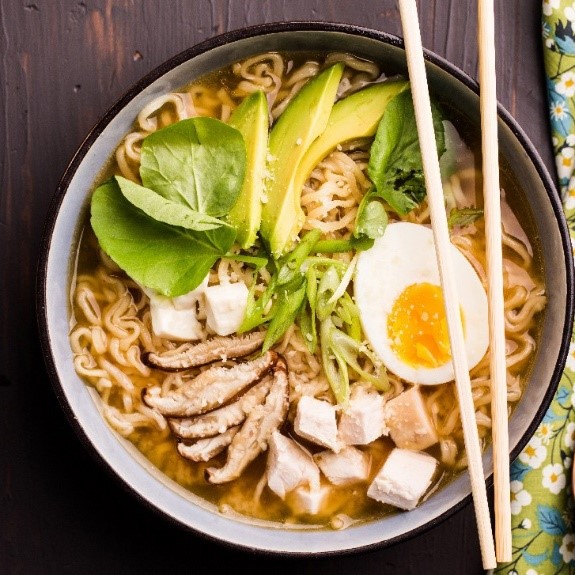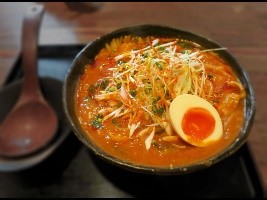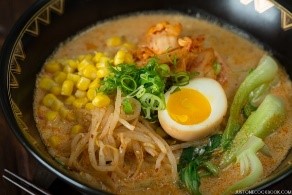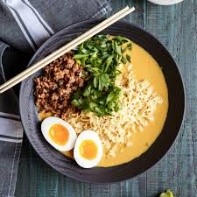Ramen is Art
What’s the first thing you think of when you hear the word ramen? You may think of a delectable bowl of noodles, the smell of boiling broth, or you might be thinking of the store-bought packet of dried noodles you can cook at home. One of the things most people probably don’t think of when they hear ramen is edible art. People don’t realize that when they eat ramen, they’re eating a bowl of art fine-tuned for flavor. There are so many little details that make ramen art, from the way it looks and tastes to the experience of eating a single bowl; ramen is a masterpiece of food. Some people might say that ramen isn’t anything special—that it’s just a bowl of noodles and soup. Well, it may be true that ramen is a bowl of noodles and soup, but there is so much more to it, so many ingredients that make the food spectacular.
One of the tastiest parts of ramen noodles is the broth. The broth is the main flavor base for the bowl and subtle things can change the way the soup tastes. In The Secret of the Soup, author Eric Lehman cooks ramen to learn why this soup tastes so good. Lehman learns this by making multiple different bowls of ramen until he makes the perfect bowl of ramen. “The broth was spectacular, with fat beading on the top, a rich, meaty flavor, all the elements balanced perfectly” (Lehman 75-90). Each bowl of ramen is carefully made with hand-picked ingredients that go into the soup before it boils continuously until all the flavors in the broth mix together and bring out some new flavors. Each and every ingredient that is put into the ramen has its own distinct flavor and you can taste all of the different flavors with just one scoop of the spoon. When the broth is finally ready, it comes out with new flavors added to it. These new flavors come from all the mixed ingredients coming together and brings out new and exciting flavors in the broth, “so, whatever it was mixed with brought out different aspects with a hint of what seemed like graham cracker” (Lehman 75-90). Adding and mixing different ingredients to your ramen broth subtly changes the flavor of the entire dish.
The visual aspects of the ramen can drastically change the feelings a person feels towards ramen.
The visual arrangement of the ramen is a good indicator if someone took their time to make the bowl of ramen or if they rushed it. The arrangement of the toppings on ramen is unlike any other food I’ve seen. How the ramen is arranged can make you even hungrier, but there is more enjoyable than receiving the most visually pleasing bowl of ramen you have ever seen. Look at the bowl of ramen on the top left, just looking at this picture makes my mouth water. The picture on the right has avocado in it, a lighter broth, and there are a lot more greens in this bowl of ramen, but that makes the bowl feel different like it would taste entirely different than the bowl on the left. Look at both of the bowls and see how each bowl’s toppings are specifically arranged. These bowls are arranged in a way that makes the ramen more appetizing and visually pleasing. Since each bowl of ramen comes with different toppings in it, that means that each bowl can have any number of combinations in it. This combination gives each bowl of ramen it’s own personality.
Look at this bowl on the left, you can tell from just the colors of the broth, the color of the egg, and the arrangement of the toppings that this bow is a spicy bowl of ramen with a lot of flavors. Now, look at another bowl of ramen on the right. This bowl feels calmer, the broth isn’t a dark red color, and neither is the egg. The flavor of this bowl looks refreshing and savory. New every bowl of ramen you have, you can customize, so you can have whatever toppings you want in your bowl. This makes eating ramen a unique experience for everyone because ramen can satisfy the flavor needs of any customer.
Now the actual experience of eating ramen is unlike any eating experience I’ve ever had. I strongly recommend that anyone who has never tried traditional ramen from a ramen shop to do so immediately. When you sit down for a bowl of ramen the first thing that hits you is the smell of everything around you. From other customers’ bowls of ramen to the boiling broth in the back, any and all smells inside a ramen shop make you crave a delectable bowl of ramen. Then your server places the bow of ramen right in front of you and this instantly puts a smile on your face. As you are about to dig into the bowl, the smells of your own bowl of ramen make your mouth water. The first bite you take is incredible, all this different flavor stands out and somehow blend so well together. The soup alone is one of the tastiest parts but when you get all the different ingredients of the ramen on your spoon and take a bite every and all flavors overwhelm your mouth.
There is so much to enjoy in just a single spoonful of ramen. “When you have your bowl of ramen, you also add things like a flavor base; in Japanese, it’s called a tare. It could be based on salt, soy sauce, miso or on a lot of different flavors, but you add that to your bowl. In addition, you add melted fat, which could be pork fat, beef fat or chicken fat depending on what flavor you’re trying to create” (Kasper). The only thing better than the flavors of the bowl are the textures you can feel when you dig in. The noodles are soft and squishy when you get a whole mouth full of these noodles it sends you mouth into heaven. The soft and delicate textures of the noodles are enough to make anyone want another bowl. “The noodles, from thin to wavy, are aged for up to ten days in a cool place to achieve their peak flavor and texture” (Utagawa 1). As for the rest of the toppings, you’ll experience a wide variety of textures, like bamboo shoots, which is are common in most bowls of ramen. They have this really tough and stringy texture to them, making the flavors really stand out. The meat they use is absolute perfection. Each slice of meat is so juicy and tender, that when you take a bite into a piece of chicken, all of the flavors come out from inside.
Now there still may be some of you who still believe that ramen isn’t art and that it’s just a bowl of noodles that I can even cook at home. To those who still believe this, let me tell you that ramen is most definitely a form of art. There are so many little details in a single bowl of ramen that can completely change the taste of the soup. All these little details come together to make a bowl of soup full of flavor and texture. “The original ingredients of this dashi differ but can be made from the aforementioned pork bones (such as from the back, feet, head), whole chickens, chicken bones, venison, anchovies, dried bonito, kelp, or vegetables. For the added flavor, adding soy sauce, miso or salt to the soup base (as in shoyu ramen, miso ramen or shio ramen) can change the soup into dozens of other kinds by delicately altering the flavor.” (Tsunagu 2). To those who believe there isn’t any difference between traditional ramen and store-bought ramen are misinformed. While store-bought ramen may have some similar tastes to traditional ramen, but one major thing its lacking is effort. Store-bought ramen is by far one of the simplest things to cook at home. All you do is boil water and pour it into a dried bed noodle then add the flavor packet. This isn’t how real ramen is made, making real ramen takes time and a whole lot of effort. With real ramen, the chef takes time to produce the exact flavor he is looking for. This process requires multiple attempts until the right flavor is achieved. “For ramen craftsmen, they produce original flavors after doing hundreds of trial and error experiments in combining dashi and the added flavors.” (Tsunagu 2). To truly become a ramen-making master, it takes years of practice and technique to make the perfect bowl of ramen. Chefs start by making the broth; they carefully choose the juiciest parts of whatever animal they want to base their soup on. Whether it be prime cuts of pork meat or the savory remains of a freshly prepared fish. They boil the broth for hours on end to draw out the delectable tastes. Throughout the boiling process, they add in different mixtures of spices and vegetables to give the dish an extra burst of flavor. Now the noodles are a completely different process. The chef prepares the noodles by creating their own dough from scratch. From there the dough rests for 30 minutes and then kneaded with a rolling pin. This is where all the years of technique come into play. The chef needs to reach a certain texture to give the noodles their distinct soft and satisfying texture. The noodles are then cut into strips and boiled to perfection. This process takes a lot of time, practice, and technique to pull off and this is why must be considered art this food is relatively easy to make but to master it takes time and a whole lot of effort.
Works Cited
Chen, Namiko. “Vegetarian Ramen,” Justonecookbook.com, www.justonecookbook.com/vegetarian-ramen/.
Cockren, Chris. “Spicy Lamb Coconut Curry Ramen,” Sharedappetite.com, sharedappetite.com/main-dishes/spicy-lamb-coconut-curry-ramen/.
Ferroni, Lara. “Turkey Ramen,” Epicurious.com, www.epicurious.com/recipes/food/views/turkey-ramen-51197040.
Goinjapanesque.com. “n/a,” Goinjapanesque.com, goinjapanesque.com/13115/.
Kasper, Lynne R. “The Art of the Slurp (or, How to Eat Ramen).” The Splendid Table, 4 Apr. 2014, www.splendidtable.org/story/the-art-of-the-slurp-or-how-to-eat-ramen.
Lehman, Eric. “The Secret of the Soup.” Gastronomica, vol. 13, no. 4, 2013, pp. 75–90.
Mccormick.com. “Soy Ginger Ramen Soup,” Mccormick.com, www.mccormick.com/simply-asia/recipes/noodles-and-sauce/soy-ginger-ramen-soup
Tsunagu. “3 Reasons Why Japanese Ramen Is So Delicious.” Tsunagu Japan, 17 Dec. 2014, www.tsunagujapan.com/3-reasons-why-japanese-ramen-is-so-delicious/.
Utagawa, Daisuke “The High Art of Ramen in Tokyo.” National Geographic, www.nationalgeographic.com/travel/intelligent-travel/2014/02/21/the-high-art-of-ramen-in-tokyo/?user.testname=none.




